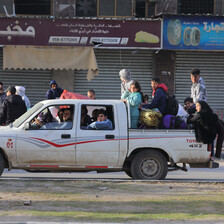The Electronic Intifada 3 December 2023

An all-too-frequent emergency at al-Aqsa Martyrs hospital in Deir al-Balah, central Gaza.
APA imagesHearing the news lately, I have often said “This is the worst that could happen.”
With Israel committing new massacres, those words become redundant. Things are getting demonstrably worse.
Sufyan Tayeh has been killed. He was president at the Islamic University of Gaza and a renowned researcher in physics and applied mathematics.
Tayeh was killed – along with his family – as they took shelter in a school in Jabaliya refugee camp.
He was a brilliant and humble man.
It appears that Israel is deliberately targeting academic and cultural leaders. It is doing so at the same time as it is attacking schools, universities and hospitals.
The Islamic University of Gaza was destroyed by Israel in October. It is now barely recognizable.
I graduated from this university in 2016. The places where I used to study are all gone.
It is not the only college that has been targeted. Al-Aqsa University and al-Azhar University have been bombed, too.
The entire education system in Gaza has been severely affected. Students have not been able to attend school since the beginning of the current war.
Schools – both public and private – have been turned into shelters.
I recently visited a school where the library, which had a space of 60 square meters, had been converted into a shelter for more than six extended families.
One of the extended families had 28 members, including six married brothers, their wives and their children.
Relentless destruction
My sister asked her 7-year-old son, whom we always considered intelligent, to read the English word “cat.”
He started reading it from right to left, which made us laugh.
Then, his father said, “Leave him alone. The child has witnessed all of this, and you expect him to remember whether English should be read from right to left or left to right.”
The destruction is relentless.
Hamad City – one of the newest housing developments in Gaza – has been attacked.
I had admired the residential towers of Hamad City. They were beautiful and, in my view, had a unique design.
Some of them have now been destroyed.
Another large residential complex has been targeted in the Shujaya neighborhood of Gaza City. Hundreds are estimated to have been killed in that attack.
I have been searching for a medication called Vastarel MR. My mother needs it for her heart condition.
I have been unable to find it.
I spent quite a lot of time going from one pharmacy to another in Deir al-Balah, central Gaza.
There are so many other people who have the same problem as us. They do not have the medicines they need.
I have met one woman who had to leave Gaza City and move into a school in Rafah, Gaza’s southernmost city.
She had forgotten to bring her son’s inhaler. Without it, he has difficulty breathing.
Some people need painkillers. Others are searching for cancer treatments.
There have been reports in the international news about humanitarian aid entering Gaza over the past week or so. Yet everything is getting scarcer.
Supermarkets have been turned into shelters. In Rafah, many people have to sleep on the street.
We are trying our best to keep in touch with members of my family who have taken shelter in Khan Younis, southern Gaza.
It felt like I had to call my sister-in-law 1,000 times before I could speak to her. When I eventually could, she talked about “belts of fire” and said that “the land is shaking beneath us.”
When I spoke to one of my brothers – who works as a nurse – he said “all the hospital’s glass was shattered” in what he called “massive airstrikes.”
We are hearing about how Israel is pushing more and more people out of their homes.
When my father told me about the atrocities carried out during Israel’s invasion of Gaza in 1967, I was initially in disbelief. Could such things really happen?
Now I believe him fully. More than 50 years later, we are witnessing horrors with our own eyes.
Ghada Abed is a journalist based in Gaza.





